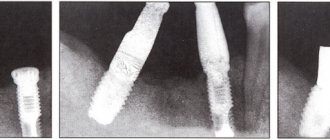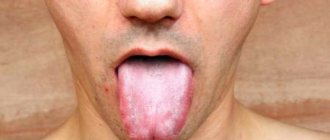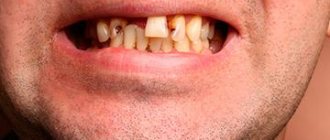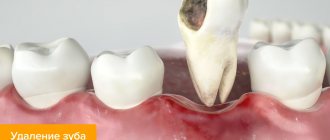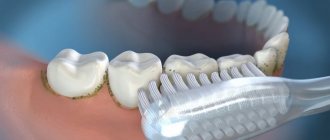Why do teeth rot in adults?
The development of caries and other dental diseases occurs under different circumstances, including:
- Insufficient oral hygiene or its complete absence.
- Poor nutrition, accompanied by the development of excess or deficiency of microelements and vitamins in the body.
- Failure to follow the rules of eating: chewing very cold or very hot food, combining hot and cold, biting into very hard foods.
- Disturbance of metabolic processes in the body.
- Endocrine diseases and temporary hormonal imbalances, due to which the protective properties of saliva are weakened.
- Pathological processes that occur during pregnancy and are associated with the outflow of nutrients from the mother’s body to the developing tissues of the fetus.
- Weak immune activity.
- Hereditary predisposition and improper formation of the dentofacial apparatus.
- The effects of nicotine and alcohol.
- The effect of toxic substances in unfavorable environmental conditions or harmful working conditions.
- Infectious processes due to injuries.
- The presence of untreated infectious processes in any part of the body.
When visiting a dentist, you rarely hear exactly why a particular dental disease has developed. Most often, unfavorable factors act on dental tissues in a complex manner and over a long period of time.
Why do children's teeth rot?
Teeth rot not only in adults, but also in children. In addition to the reasons described, children’s teeth are affected by additional factors that often arise due to the fault of parents:
- Improper nutrition of the mother during pregnancy, due to which the formation of bone and dental tissue of the fetus is abnormal.
- The effect of toxins and medications that enter the mother’s body through smoking, drinking alcohol or self-medicating.
- Long-term use of pacifiers and bottle nipples.
- Night feeding - at night, food particles linger in the mouth for a long time and rot due to the activity of bacteria.
- Late and incorrect teaching of children to maintain hygiene.
- Eating large amounts of sweets, the remains of which create favorable conditions in the mouth for the proliferation of microbes.
Treatment of tooth root perforation with MTA bioceramics!
Tooth perforation (tooth root perforation) is one of the most common complications of dental treatment. Usually, dentists, when faced with such a problem, recommend that the tooth be removed immediately. However, modern research has shown that perforation of the tooth root is not a reason for its removal . Advances in medicine make it possible to save such teeth, and in the vast majority of cases.
Dentists at the Bionic Dentis clinic have successfully mastered the treatment of tooth root perforation using MTA bioceramics. We cure perforations in 98% of cases!
What to do if your teeth are rotting
Rot inside the tooth is dangerous for the entire body. Therefore, at the first signs of decay of dental tissues, you should go to the dentist.
Before providing first aid, it is recommended:
- Rinse your mouth with a herbal decoction that has anti-inflammatory and antimicrobial effects. It's better to take chamomile and sage.
- Rinse your mouth with a pharmaceutical antiseptic: Chlorhexidine, Miramistin.
- Thoroughly clean the surface of the dentition to prevent the accumulation of soft plaque and its transformation into hard tartar: bacteria multiply under its surface and spoil the enamel even faster.
- You should not try to remove pus yourself by picking at the enamel with a sharp object. This action will provoke even greater destruction of damaged tissue.
- On the side of the jaw where the rotten tooth is located, it is better not to chew anything so that food does not penetrate into the carious holes.
- After eating, you need to rinse the remaining pieces of food with a weak saline solution or boiled water.
Tooth root perforation - classification.
Tooth perforation is a communication between the internal cavities of the tooth with the external environment or surrounding tissues. Such a message can appear naturally, for example, as a result of the carious process, the tooth can “rotten” through or as a result of the actions of the dentist.
Perforation can be localized:
- in the area of the bottom of the pulp chamber of the tooth.
- in the root wall;
Can a dead tooth hurt?
The appearance of pain in a dead tooth depends on the stage at which necrosis progresses. At the very beginning there is usually no pain. During the transitional stage, the already mentioned throbbing toothache may appear. It is a consequence of retention of purulent exudate and usually worsens in a lying position. After its cessation, complete necrosis of the dental pulp occurs.
Pain can also occur as a result of dental treatment. If a dentist places a prosthetic crown that is too large on a tooth, there is a high probability of overloading the tooth and causing periapical changes. In this situation, pain usually occurs during chewing. It can be easily eliminated at your next visit to the dentist by shortening the crown.
Tooth root perforation - causes.
The appearance of tooth root perforation during dental intervention is caused by:
- Strong bends of the root canals (i.e. individual features in the anatomy of the root canals). The fact is that the dentist uses instruments that are initially straight and when inserted into the root canal, they can pierce it in an unplanned place.
- Teeth previously treated with resorcinol-formalin method. This technique was widely used in the USSR. As a result of this treatment, the root canal was not cleared of contents, but was filled with a medicinal mixture. Under the influence of this mixture, the tooth became glassy and changed its color to red-brown. However, several years after such treatment, teeth begin to decay, and microorganisms that were not cleaned out of the root canal begin to multiply, leading to inflammation at the root apex, granuloma or cyst. In this case, the dentist begins to clean the root canals again. However, over the years, a very strong “glassy” substance is formed at the root of the tooth. It is much stronger than root tissue. As a result of attempts to unfill such a canal, the dentist pierces the canal in the wrong place.
- A common cause of tooth root perforation is inappropriate expansion of the root canal to prepare it for an intraradicular pin or intraradicular inlay. The dentist may rush and the rotating instrument will pierce the canal in the wrong place.
- In clinics where a radiovisiograph is not used to control the shape of the root canal, the doctor does not know in advance how the tooth root is going. If the dentist starts looking for a root canal “at random” without first taking an x-ray. In this case, he will most likely make a perforation in the tooth.
- One of the most dangerous perforations of the tooth root is band perforations, which appear from excessive expansion of the tooth root. A dentist who does not use x-rays may overdo the cleaning and enlargement of the root canal, resulting in a perforation.
The natural cause of perforation is carious destruction of dental tissues. If the patient delays dental treatment, the tooth can “rot” through.
Some patients are at higher risk of root perforation:
- with difficulty opening the mouth. In this case, the dentist has difficulty seeing what he is doing, which increases the risk of perforation.
- for uneven teeth and malocclusion. In this case, the roots of the teeth are located atypically, and the dentist looks for them in familiar places. These teeth are most often subject to perforation.
- for narrow, short, crooked root canals.
- when treating teeth through an artificial crown.
- in the presence of resorcinol-formalin teeth.
- when re-treating teeth treated in the USSR or state dental clinics.
The root canal system of the tooth (especially in the lateral) part of the jaw is highly complex. Treatment of such canals requires a highly qualified dentist, the availability of specialized endodontic instruments and augmentation systems in the clinic.
Only 3 percent of Russian clinics can provide adequate quality in the treatment of dental pulpitis and periodontitis.
The Bionic Dentis clinic specializes in complex cases of dental treatment. We cope 100% even in the most difficult clinical cases.
Causes of depulpation
There are a number of indications for dental nerve removal. Depulpation is most often carried out in the following cases:
- with extensive carious lesions affecting the dental nerve;
- development of infection in the dental canal;
- mechanical damage to the pulp;
- In the process of preparing for prosthetics, even a healthy pulp may be removed; this is necessary to eliminate the risk of developing re-inflammation in the tooth after the installation of an orthopedic structure.
The procedure for removing pulp from a tooth is performed in the following sequence: 1. Based on an x-ray taken, the doctor determines the structure and size of the dental canals. 2. Local anesthesia is administered. 3. The pulp is removed first in the coronal and then in the root part of the tooth. 4. Dental canals without pulp are carefully treated with an antiseptic solution. 6. After treatment, the canals are sealed. 7. Most often, a temporary filling is subsequently placed on the tooth, which later must be replaced with a permanent one.
Tooth root perforation - symptoms.
It should be noted that at first, if the patient has a perforation of the tooth root and the dentist does not close it, then the patient will not experience any unpleasant sensations.
The clinical picture will appear only when an inflammatory process occurs in the area of perforation in the jaw bone tissue. This may take several years.
Perforation with an inflammatory process gives the following symptoms:
- spontaneous pain in the area of the affected tooth;
- swelling and redness of the gums over the area of inflammation;
- the presence of a fistula on the gum
- flux formation
- sharp pain when the affected teeth bite hard food
The diagnosis of tooth root perforation is quite difficult in some cases.
The dentist performs radiovisiography of the tooth or uses computed tomography. On tomography, perforations can be suspected in places where the bone tissue is inflamed. However, in cases where the cause of perforation of the tooth root is a root post or inlay, this is clearly visible on the image or tomography.
Sometimes, to determine the location of the perforation, it is necessary to first clear the root canals of old filling material.
Treatment of root perforation with MTA bioceramics
Determining the tactics for treating a tooth with perforation depends on its location and the size of the inflammation in the bone tissue in its area.
Tactics of dentists at the Bionic Dentis clinic
Many years of experience and training in Germany have led us to the optimal technique, which gives 90% percent of positive treatment outcomes:
- The old or temporary filling is removed from the tooth. This gives the dentist access to the pulp chamber of the tooth.
- The root canal is cleaned with an ultrasonic tip. We use the SIROSONIC SIRONA ultrasound system (Germany).
- When a canal is found, it is cleaned using a computerized root canal machine system. We use the latest generation endodontic system from VDW (Germany)
- The tools used are files made from a particularly durable medical alloy. With these instruments, the canal is cleared of residual filling material and infection.
- The cleaned root canal and perforation are disinfected with a French antiseptic solution from SEPTODONT.
- The antiseptic solution is activated by ultrasound. The cavitation effect caused by ultrasound causes the antiseptic to activate and penetrate to the maximum depth into the tooth tissue and clean the perforation.
- Perforation is processed by laser. The use of the SIROLASER SIRONA SIEMENS laser unit (Germany) allows our doctors to carry out the most thorough treatment, which is not available with other methods. It is the laser that ensures a successful treatment outcome.
- The root perforation is closed with a special preparation - bioceramics. This is a new development of scientists - a drug based on inorganic compounds. Bioceramics are extremely biocompatible, non-toxic, non-shrinking and chemically stable in the biological environment. And besides, which is very important for endodontics, bioceramics do not lead to an inflammatory reaction even when taken outside the root canal.
- The root canal is filled using the 3D technique. This unique technique was developed in Germany. With this method, hot plastic (alpha gutta-percha) is used to fill the root canal and perforation canal in some cases. The technique ensures lifelong sealing of the canal, which is the key to the absence of relapses of the disease.
- The tooth is restored with a filling, inlay or crown.
How to recognize a dead tooth?
When a tooth dies, many adverse reactions occur. With the necessary knowledge, you can easily recognize the problem. Due to irritation of the tissues around the tooth, gum abscess (in the form of a thick discharge consisting mainly of bacteria) and swelling may occur. A dead tooth can also be recognized by its dark, unnatural color, which is the result of cell death, and by its complete lack of response to any stimuli (heat, cold, or electrical stimuli). In the transitional stage preceding the death of the pulp, there may be increased sensitivity to heat and cold, as well as throbbing toothache.
In the last stages of tooth death, fever, chills and jaw pain may appear. Tarnishing of the enamel is also a warning sign. If any of the above symptoms appear, a visit to a specialist may be required to make a final diagnosis.
Tooth root perforation - cost of treatment.
We save teeth with perforations thanks to unique equipment, drugs and the qualifications of dentists:
- Treatment of perforations is carried out by our dentists under magnification using a dental microscope or binocular loupes.
- During treatment, a German computerized root canal cleaning system is used, which allows the dentist to accurately move along the root canal while cleaning it.
- Each stage of treatment is controlled by the XIOS SIEMENS radiovisiographic system (Germany). As mentioned above, perforations usually occur on teeth with curved canals, so the dentist must visually see where it is.
- When taking x-rays, we use a contrast agent that clearly identifies the location of the perforation.
- The root canal and perforation are cleared of contamination using the SIROSONIC SIEMENS ultrasonic system.
- To disinfect the canals, we use French broad-spectrum antiseptics from the company. This drug is recognized as the most effective in its field.
- The main feature of the treatment of perforation in our clinic is the use of the SIROLASER SIEMENS dental laser. This latest generation installation allows us to sterilize the root canal, the perforation area and laser treatment of the defect in the canal wall, which greatly increases the likelihood of tissue healing and relieves inflammation.
- We use premium-level bioceramics; this bioceramics is 100% compatible with tooth tissue and reliably closes the perforation hole.
Warning
: Invalid argument supplied for foreach() in
/var/www/u0695953/data/www/bionicdentis.ru/wp-content/themes/bionic/single-service.php
on line
59
| № | Procedure/manipulation | Price, rub.) |
Werner Elena Vladimirovna
Dentist periodontist
More details
Eremina Anna Arturovna
Dentist therapist
More details
Ozerov Petr Vladimirovich
Chief physician. Dentist, implantologist, orthopedist, surgeon. Laser dentistry specialist
More details
In what cases is the nerve removed from a tooth?
First, let's look at why pulp removal (dental nerve) or depulpation is performed. The need for depulpation arises for several reasons. Practicing dentists identify the following indications for this operation:
- the occurrence of pulpitis: damage to the neurovascular bundle due to the spread of caries,
- extensive deep carious cavity: if the defect is more than 50% of the total volume of the crown, then a filling cannot be placed (it will not hold well and will quickly fall out), and other restoration options - pins, inlays, crowns - involve depulpation,
- the presence of several carious cavities: grinding down the enamel and removing infected dentin can significantly increase the size of the defect, i.e. again, the crown will have to be restored in such a way that pulp removal will have to be carried out,
- mechanical trauma: when a horizontal root crack is detected, for example, periodontitis: inflammation of the tissues of the ligamentous apparatus-1 surrounding the roots.
Prognosis for treatment of root perforation:
The technique used in the Bionic Dentis clinic makes it possible to state: 95% of teeth with perforations can be successfully treated, and they will last for decades.
We have accumulated extensive experience in applying the technique and are experts in this matter.
In teeth with treated perforations, there is one point that is important to consider:
These teeth should not be used as support for bridges.
Over many years of practice in our clinic, more than 500 teeth with perforations have been successfully treated, and we have been able to observe such patients since 2006.
If you need to treat a tooth with perforation and save it from removal, we will apply all our experience and technical equipment to this.
As a result of contacting our clinic, we will save your tooth with perforation, which will serve you for several decades and eliminate the need to remove the tooth and install an implant.



